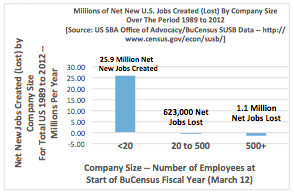The very small businesses, with fewer than 20 employees, have created all of the net new jobs in the United States over the period from 1989 to 2012 based on the data provided by the Office of Advocacy, U.S. Small Business Administration and the Bureau of Census. Total job creation over these 23 years was 24,182,049 net new jobs and companies with less than 20 employees created 25,909,322 jobs. Figure 1 shows the total net new jobs created by all companies reported by BuCensus/Advocacy according to company size at the start of the Fiscal Year. Figures 2 through 4 show the individual charts of net new job creation (loss) for the company sizes of: less than 20 employees; 20 to 500 employees; and more than 500 employees.
Fewer than 20 Employee Companies Always Created Jobs Except During The Great Recession: It is interesting that the very small companies always created jobs (more than 1 million jobs each year for 16 of the 23 years), with the exception of FY-2009, the Great Recession. The mid-sized firms lost jobs in 9 of the 23 years, and never contributed more than 1 million job per year. The large firms lost jobs in 10 of the 23 years (more than 1 million jobs lost in 4 years, and more than 2 million jobs lost in 2 years). The large firms only created slightly more than 1 million jobs in 2 years. Clearly, the mid-size and large firms are more chaotic in job creation/loss than the very small firms.
Very Small Companies Are Important For Economic Development Strategies: The following article by the Kansas City Federal Reserve is enlightening:
“Increasingly, economic development experts are abandoning traditional approaches to economic development that rely on recruiting large enterprises with tax breaks, financial incentives, and other inducements. Instead, they are relying on building businesses from the ground up and supporting the growth of existing enterprises. This approach has two complementary features. The first is to develop and support entrepreneurs and small businesses. The second is to expand and improve infrastructure and to develop or recruit a highly skilled and educated workforce. Both efforts depend in large part on improving the quality of “life in the community and creating an attractive business climate.”
“At first glance, the net new job figures are difficult to reconcile with the fact that, over the same period, small firms’ share of total employment actually fell. In 1990, small firms employed 20.2 percent of all workers, while large firms employed 46.3 percent. In 2003, the numbers for small firms dropped to 18.4 percent but climbed to 49.3 percent for large firms. The explanation lies in the migration of firms across size classes from year to year. In any given year, some small firms will grow beyond 20 workers and join a larger size class.”
 State and Local Government Policies Affect Very Small Company Start-up and Expansion: State and local policies that restrict start-ups and expansions by imposing burdensome licensing and building permit fees can reduce the opportunities for net new job growth in their regions. Progressive local and state governments have instituted “One-Stop” permitting and building permit offices to simplify the time and reduce the cost of obtaining business licenses and building permits for opening and expanding small businesses.
State and Local Government Policies Affect Very Small Company Start-up and Expansion: State and local policies that restrict start-ups and expansions by imposing burdensome licensing and building permit fees can reduce the opportunities for net new job growth in their regions. Progressive local and state governments have instituted “One-Stop” permitting and building permit offices to simplify the time and reduce the cost of obtaining business licenses and building permits for opening and expanding small businesses.

